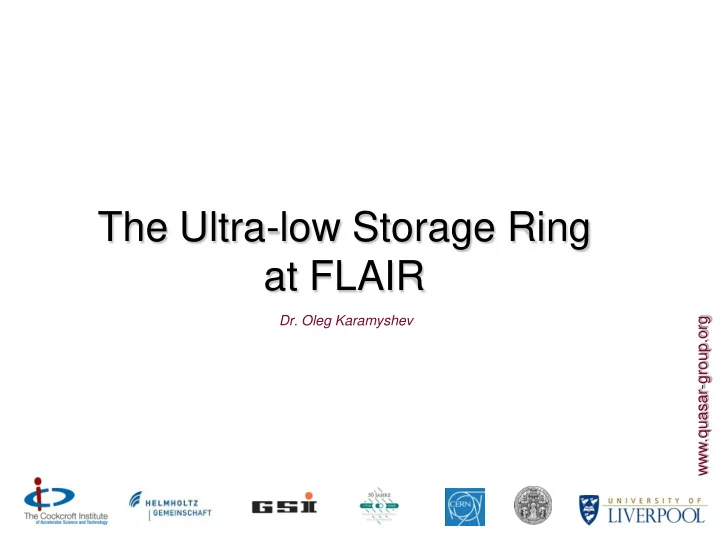

The Ultra-low Storage Ring at FLAIR www.quasar-group.org Dr. Oleg Karamyshev
Overview Motivation Present situation and future projects Electrostatic rings USR – Design – Optimization, operation modes – Beam Instrumentation Conclusion Oleg Karamyshev, LEAP 2013, Uppsala, Sweden
Present Situation: AD @ CERN Target p 26 GeV/c p 3.57 GeV/c p Yield: 4 . 10 -6 Experiments e - Cooler Stoch. Cooling Oleg Karamyshev, LEAP 2013, Uppsala, Sweden
Problem: 5 MeV too high for trapping ! > 99.9 % of pbars lost in degrader. ~ 10.000 pbars/shot ASACUSA: RFQ-D ~ 2.000.000 pbars/shot BUT: ∆ E/E, ε x,y Oleg Karamyshev, LEAP 2013, Uppsala, Sweden
Low energy pbar rings AD LSR USR ELENA Energy range Down to 30 MeV – 300 keV – 5 MeV – 5.3Mev 300 keV 20 keV 100 keV 1.2x10 7 1x10 9 – 2x10 8 – Intensity 2x10 8 1x10 7 Beam modes Fast Fast Slow/fast Fast extraction extraction extraction, ns extraction bunches, merged beam Oleg Karamyshev, LEAP 2013, Uppsala, Sweden
@ Facility for Antiproton and Ion Research Beam Low-Energy USR Experiments Oleg Karamyshev, LEAP 2013, Uppsala, Sweden
Magnetic ↔ Electrostatic B E Oleg Karamyshev, LEAP 2013, Uppsala, Sweden
The First Electrostatic Ring Prototype for the AGS in Brookhaven Oleg Karamyshev, LEAP 2013, Uppsala, Sweden
Existing Electrostatic Rings KEK, Japan ELISA, Denmark TMU Oleg Karamyshev, LEAP 2013, Uppsala, Sweden
USR – First Design in 2005 and Ring Re-Design How to realize nanosecond bunches ? How to extract the beam ? ns Bunching Steps: General feasibility 1-D simulation FLAIR TR Full study Welsch, C.P., et al. Nucl. Instrum. Methods A 546 405–417 (2005) Oleg Karamyshev, LEAP 2013, Uppsala, Sweden
Modification to USR Lattice "Split-achromat" geometry, new concept. Achromatic section, D=D‘=0 in straights. D never > 0.6 m . A.I. Papash, et al, Proc. PAC (2009) Oleg Karamyshev, LEAP 2013, Uppsala, Sweden
Staged approach Deceleration of beam to 20 keV e - cooling to ∆ E/E=5 . 10 -4 Capture beam @ 20 MHz (50 ns) 3 βλ /2 buncher / debuncher A. Papash, C.P. Welsch, Part Phys. Nucl. Letters 3 (2009) Oleg Karamyshev, LEAP 2013, Uppsala, Sweden
Evolution in Phase Space Crucial: Dispersion in straight section ! A.I. Papash, C.P. Welsch, PPNL 6 (3) (2009) A.I. Papash, C.P. Welsch, Nucl. Instr. Meth. A 620 (2010) Oleg Karamyshev, LEAP 2013, Uppsala, Sweden
USR – Advanced Studies Full 3D ring model, detailed studies (OPERA, MAD-X) Explained life time, ∆ p/p, etc. Dynamic Aperture Beam Loss O. Gorda, A.I. Papash, C.P. Welsch, Proc. IPAC (2010) A.I. Papash, A. Smirnov, C.P. Welsch, Phys. Rev. STAB 16 060101 (2013) Tune Shift Oleg Karamyshev, LEAP 2013, Uppsala, Sweden
Beam Dynamics ELISA. Magnesium. Momentum spread. BETACOOL 1.E-03 ELISA decays of stored O- beams at 22 keV. BETACOOL simulations 1.0E+08 9.E-04 1.0E+07 Momentum spread, dP/P Intensity, ions 7.E-04 1.0E+06 5.E-04 1.0E+05 3.E-04 1.0E+04 0 10 20 30 40 50 60 Time, sec 1.E-04 0.0001 0.001 0.01 0.1 1 Time after injection, sec Use ELISA for benchmarking S.P.Moller. „Intensity Limitations of the Electrostatic Storage Ring ELISA“. Proc. of EPAC-2000. p.788-790 A.I. Papash, A. Smirnov, C.P. Welsch, Phys. Rev. STAB 16 060101 (2013) Oleg Karamyshev, LEAP 2013, Uppsala, Sweden
USR - slow/fast Extraction Goal: Combined system, providing highly-flexible extraction Motivation: Nuclear physics-type experiments. First time in electrostatic ring ! Used: Comsol, benchmarked against OPERA results. G. Karamysheva, A.I. Papash, C.P. Welsch, Part Phys. Nucl. Letters 8 (2011) Oleg Karamyshev, LEAP 2013, Uppsala, Sweden
Sextupole Integration x [m] G. Karamysheva, A.I. Papash, C.P. Welsch, Part Phys. Nucl. Letters 8 (2011) Oleg Karamyshev, LEAP 2013, Uppsala, Sweden
USR - Technical Design C.P. Welsch, et al., TDR, in prep. (2013) Oleg Karamyshev, LEAP 2013, Uppsala, Sweden
USR – Diagnostics J. Harasimowicz, et al., Hyperfine Interact. (2009) J. Harasimowicz, et al., Rev. Sc. Instr. 81 (9) (2010) J. Harasimowicz, et al., Phys. Rev. STAB 15 (2012) Position Profile Intensity AEgIS Setup – see poster Oleg Karamyshev, LEAP 2013, Uppsala, Sweden
Profile Measurement and Collision Experiments: Prototype Setup Proof-of-principle setup at the CI; Gas jet and IPM; Designed for use with low energy antiproton beams: ‐ Profile Monitor ‐ Atomic physics experiments. M. Putignano, C.P. Welsch, Hyperfine Interact. (2009) M. Putignano, C.P. Welsch, Nucl. Instr. Meth. A (2012) Oleg Karamyshev, LEAP 2013, Uppsala, Sweden
Antimatter Research – Future USR TDR being finalized – Ring design – All diagnostics – Opimization done against experimental program ELENA Storage Ring – Ring design – Life time studies – Beam lines AEgIS setup – Detector and instrumentation tests Oleg Karamyshev, LEAP 2013, Uppsala, Sweden
Conclusion Low energy pbars exciting tool for fundamental research; USR ring design, incl. mechanical design, done and TDR submitted; Detailed understanding of beam dynamics; Beam instrumentation prototypes developed and tested; setup at AEgIS Many thanks for your attention ! ...and to all QUASARs who contributed. Oleg Karamyshev, LEAP 2013, Uppsala, Sweden
Recommend
More recommend